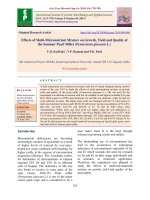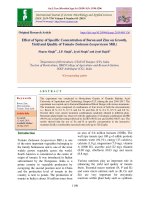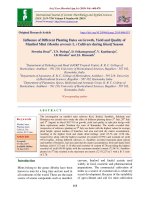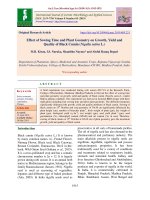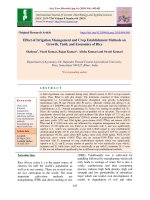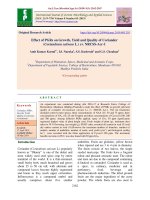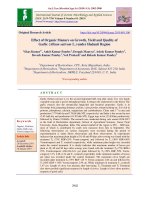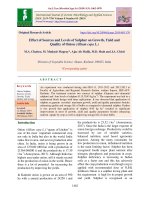Effect of different types of organic source of nutrition on growth, yield and quality of Ashwagandha roots (Withania somnifera Dunal.)
Bạn đang xem bản rút gọn của tài liệu. Xem và tải ngay bản đầy đủ của tài liệu tại đây (157.31 KB, 5 trang )
Int.J.Curr.Microbiol.App.Sci (2018) 7(8): 3196-3200
International Journal of Current Microbiology and Applied Sciences
ISSN: 2319-7706 Volume 7 Number 08 (2018)
Journal homepage:
Original Research Article
/>
Effect of Different Types of Organic Source of Nutrition on Growth, Yield
and Quality of Ashwagandha Roots (Withania somnifera Dunal.)
Pankaj Chaudhary*, D. Ram and Mudit Mishra
Department of Horticulture, College of Horticulture and Forestry, Narendra Deva University
of Agriculture and Technology, Faizabad-224229 (U.P.), India
*Corresponding author
ABSTRACT
Keywords
Organic, Pressmud,
Vermicompost,
PSB, Growth
parameters, etc
Article Info
Accepted:
17 July 2018
Available Online:
10 August 2018
The present investigation has been carried out to find out the most effective organic source
for better plant growth attributing characters of ashwagandha (Withania somnifera Dunal.).
The experimental findings were taken on plant growth attributing characters. In present
study growth attributing characters such as plant height (40.60 cm) was found significantly
superior with application of vermicompost (5 ton/ha) has been found inferior in control
(16.40 cm). Data on plant spread (cm2) indicated that non-significant variation observed
the maximum plant spread (24.20 cm2) was measured with the application of
vermicompost (5 ton/ha). Number of branches per plant indicated that significant variation
observed with the application of various organic treatments. The maximum number of
branches per plant (5.13) was found with the application of vermicompost (5 ton/ha) as
compared to other organic treatments and all the vermicompost doses were significantly
superior over the control. Plant and stem length data observed with the application of
different organic treatments. The maximum stem length (37.40 cm) was found in the
application of vermicompost (5 ton/ha) as compared to other organic treatments and all the
vermicompost doses were significantly superior over the control.
Introduction
Ashwagandha
or
Asgandh
(Withania
somnifera Dunal.) popularly known as „Indian
Ginseng‟ belongs to the family Solanaceae
chromosome no. 48. It is found in wild state in
the Mediterranean region of North Africa. In
India it is mainly cultivated in Mandsaur
district of Madhya Pradesh, adjoining villages
of Kota district of Rajasthan, Punjab and
Karnataka. It is also found wild in forest
grazing grounds in Mandasur and forest land
in Bastar district of Chattisgarh, all over the
foot hills of Punjab, Himachal Pradesh and
western Uttar Pradesh (Nigam and
Kandhalkar, 1995).
Ashwagandha is cultivated over an area of
10,780 ha in India. The annual demand of the
root was increased due to necessitated
expansion of area under this crop with
improved productivity (CIMAP, 2006). Due to
increasing demand of roots in recent times and
considering its future demand, there exists
much scope for extensive cultivation of this
crop in India.
3196
Int.J.Curr.Microbiol.App.Sci (2018) 7(8): 3196-3200
Ashwagandha roots and occasionally its leaf
and seeds are used in ayurvedic and unani
medicines preparations. The important
alkaloid present in the roots is with a nine
constituting 38 per cent of the total alkaloids.
Other alkaloids recorded are somniferine,
somniferinine,
somnine,
withanine,
pseudowithanine,
withananinine
and
withasomine (Majumdar, 1955). The total
alkaloid content of the Indian roots is reported
to vary between 0.13 to 0.31 per cent. Apart
from roots, alkaloids have also been reported
in leaves and berries (Sreerekha et al., 2004).
The roots are prescribed in medicines for
hiccup, several female disorders, bronchitis,
rheumatism, dropsy, and stomach and lung
inflammation and skin diseases. They are
mostly used for curing general and sexual
debilities. Roots are having anti- aging
property. The leaves are used to cure eye balls,
and swellings of hands and feet, in treatment
of syphilis, to kill the lice infecting the body.
The leaf decoction is used for treatment of
haemorrhoids and arthritis. Warm leaves are
sometimes used for providing comfort in eye
diseases (Nigam and Kandalkar, 1995). The
root bark is administered to patients of asthma
and other chest complaints. The green berries
are used for treating ringworm. It is also a
potential antimicrobial agent with antifungal
activity and moderate antibacterial activity
against
Staphyloccus
aureus
and
Pseudomonas aeruginosa (Choudhary et al.,
1995).
Several researches had been conducted for the
application of chemical fertilizers in the
ashwagandha crop but research targeting the
use of organic source of nutrition is at infant
stage. Use of organic source of nutrition not
only improves the soil health but also
improves the quality of alkaloids obtained
from the ashwagandha roots. It can be a step
toward sustainable method of cultivation as
application of chemical fertilizers is depleting
the soil health. The experiment aims to check
the effect of application of organic sources of
nutrition for crop yield and quality.
Materials and Methods
In the present study ashwagandha cultivar
Nimitli-118 was taken as experimental
material to find out the “Effect of different
types of organic sources on growth, root yield
and quality of Ashwagandha (Withania
somnifera Dunal.).” The experimental site is
located at Narendra Deva University of
Agriculture and Technology, Kumarganj,
Faizabad at a distance of 42 km away from
Faizabad district head quarter. Geographically
it is situated at 26.47° N Latitude, 88.12
longitudes and at an attitude of 113 meter
from mean sea level (MSL). The site is
located in typical saline alkali belt of indogangetic plains of eastern Uttar Pradesh. After
preparation of land, the experiment was laid
out as per treatment combination. There were
33 plots and net size of plot was 4×2.4 m2.
The each plot was well connected with subirrigation channel. Total 11 treatments were
taken following different combinations of
Pressmud,
Farmyard
manure,
PSB
(Phosphorus solubilising Bacteria) and
Vermicompost. Five plants were randomly
selected from each treatment and tagged for
recording the observation and average of these
five plants were taken for the study. The
observations recorded during the course of
investigation are as follows.
Plant growth character
Plant height was recorded at harvesting time
with the help of meter scale from ground level
to the tip of the main shoot of the plant and the
average was calculated on the basis of five
plants and expressed in centimeter. Spread of
plant measured at harvesting time with a meter
scale in East-West and North-South directions
and average was calculated on the basis of five
3197
Int.J.Curr.Microbiol.App.Sci (2018) 7(8): 3196-3200
plants. Total number of branches per plant was
counted visually at the crop at harvesting time.
Stem length was recorded at harvesting time
with the help of meter scale from ground level
to the distal end of the main shoot of the plant
and the average was calculated on the basis of
five plants and expressed in centimeter. The
length of root was measured after harvesting
from the proximal cut end to distal end of root
tip with the help of meter scale in centimeter.
The girth of root was measured after
harvesting with the help of vernier calipers at
the three portion of root i.e. upper, middle and
lower and the average value of these were
recorded for girth of roots in millimeter.
Statistical Analysis:
Statistical analysis of the data obtained in
different set of experiment were calculated, as
suggested by Panse and Sukhatme (1985).
Analysis of variance
The standard error (SEm±) of the difference
between two treatment means were computed
as follows:
Results and Discussion
Growth attributing characters
Data pertaining to plant height is influenced
by the use of different organic treatments as
source of nutrition clearly indicated that
vermicompost (5 ton/ha) has been found
significantly superior (40.60 cm) and inferior
in control (16.40 cm). Organic nutrition that
promotes soil health with enhancement of soil
biological activity and maintenance of soil
productivity is considered necessary for
sustainable crop production. Although these
organic sources influenced plant height
significantly higher measured with the use of
vermicompost might be due to containing
higher organic matter as well as NPK. It is fact
that vermicompost gives strength in the
rooting media i.e. soil. It indicates that these
vermicompost doses influenced the plant
height in a test way and all the vermicompost
doses, individually has been found
significantly superior over control. Similar
results were observed by Swathi et al., (2010),
Aishwath (2004) in ashwagandha and
Karuppaiah (2005) in French marigold.
Data on plant spread (cm2) indicated that nonsignificant variation observed due to
application of various organic treatments. The
maximum plant spread (24.20 cm2) was
measured due to the application of
vermicompost (5 ton/ha) than other organic
treatments. Moreover, all the vermicompost
doses increase the plant spread except control
which may be because of their role in
influence in plant spread of ashwagandha.
Similar results were observed by Swathi et al.,
(2010) in ashwagandha, Joy et al., (2005) in
black musli and Ram et al., (2008) in kalmegh
(Table 1).
Data on number of branches per plant
indicated that significant variation observed
due to application of various organic
treatments. The maximum number of branches
per plant (5.13) was found with the application
of vermicompost (5 ton/ha) as compared to
other organic treatments and all the
vermicompost doses were significantly
superior over the control, which might be due
to the role of vermicompost increasing in
number of branches per plant. Similar results
were observed by Shinde et al., (2013) in
ashwagandha and Nagarani (2008) in mentha.
Data pertaining to stem length indicated that
significant variation observed due to
application of different organic treatments.
3198
Int.J.Curr.Microbiol.App.Sci (2018) 7(8): 3196-3200
Table.1 Effect of different organic source of nutrition in plant growth characters
Sr. No.
1
2
3
4
5
6
7
8
9
10
11
Treatments
Control
FYM (5 ton/ha)
FYM (10 ton/ha)
Vermicompost (2.5 ton/ha)
Vermicompost (5 ton/ha)
Pressmud (5 ton/ha)
Pressmud (10 ton/ha)
Bio-fertilizer PSB (10
kg/ha)
FYM (5 ton/ha) + PSB (10
kg/ha)
Vermicompost (2.5 ton/ha)
+ PSB (10 kg/ha)
Pressmud (5 ton/ha) + PSB
(10 kg/ha)
SEM
C.D. at 5%
Plant growth Attributing characters
Plant
No. of
Stem
Root
spread branches length
length
(cm2)
(N)
(cm)
(cm)
17.43
2.26
12.80
10.64
16.93
3.86
17.60
11.18
18.13
3.06
18.33
13.02
24.13
4.66
30.06
14.98
24.20
5.13
37.40
15.59
21.70
3.93
29.93
11.96
19.40
3.00
31.00
13.25
20.66
4.00
29.13
13.81
Plant
height
(cm)
16.40
21.13
21.60
33.26
40.60
33.46
34.26
32.60
Girth
of root
(cm)
0.63
0.71
0.79
0.86
0.99
0.60
0.78
0.80
25.33
18.40
2.80
21.73
14.02
0.83
26.06
17.23
2.93
22.66
14.15
0.84
23.36
17.26
2.33
19.93
14.86
0.98
1.32
3.88
2.02
NS
0.34
1.00
1.30
3.84
0.78
2.29
0.07
0.20
The maximum stem length (37.40 cm) was
found due to application of vermicompost (5
ton/ha) as compared to other organic
treatments and all the vermicompost doses
were significantly superior over the control,
which might be due to the role of
vermicompost in increasing of stem length.
Similar results were observed by Swathi et
al., (2010) and Aishwath (2004) in
ashwagandha.
The maximum plant height (40.60 cm) was
recorded
with
the
application
of
vermicompost 5 ton/ha as compare to other
treatments. The maximum plant spread (24.20
cm2) and number of branches (5.13) was
observed
with
the
application
of
vermicompost 5 ton/ha as compare to other
treatments. The maximum stem length (37.40
cm) was recorded with the application of
vermicompost 5 ton/ha as compare to other
treatments. The maximum root length (15.59
cm) and girth (0.99 cm) were recorded with
the application of vermicompost 5 ton/ha as
compare to other treatments.
References
Aishwath, O.P. (2004). Mineral nutrition and
growth of Withania somnifera. J. Trop.
Med. Plants, 5(1): 111-118.
Barche, Swathi; Kamal Kirad, S. and Tomar,
R.K.S.
(2010).
Response
of
ashwagandha to organic manure and
Biofertilizers. Abstracts 97th Indian Sci.
Congress pp: 102.
Choudhary, M.I., Dur-e-Shahwar and
Praveen, Z. (1995). Phytochemistry
40:1243-1246.
Joy, P.P., Savithri, K.E., Samuel, Mathew;
Thomas, J. and Kochurani Kurien
(2005). Effect of sole and combined
3199
Int.J.Curr.Microbiol.App.Sci (2018) 7(8): 3196-3200
application of FYM and fertilizer on
growth yield and quality of black musli
27: 454-461.
Karuppaiah, P. (2005). Effect of Azospirillum,
Phosphobacteria and organic manures
on growth and yield of French marigold
(Tagetes patula L.). Plant Archives 5: 2,
661-664.
Nagarani (2008). Effect of organic manures
on Mint (Mentha arvensis L.) M.sc.,
(Hort) Thesis submitted to A. N. G. R.
A. U, Hyderabad.
Nigam, K.B. and Kandalkar, V.S. (1995).
Ashwagandha.
Advances
in
Horticulture, Medicinal and Aromatic
plants. Eds. Chadha, K L and Gupta R
Malhotra Publishing House, New Delhi,
11: 333-344.
Panse, V.G. and Sukhatme, P.V. (1987).
Statistical methods of agricultural
workers, ICAR, New Delhi.
Shinde, Ashashri; Pankaj, Gahunge; Singh,
Paramaveer; Rath, Kumar Sudipt and
Khemani, Naresh. (2013). Effect of
inorganic fertilizers and organic
manures on growth, quality and yield of
Ashwagandha (Withania somnifera
Dunal) cv. Jawahar Ashwagandha - 20.
Ann. Pharm. & Pharm. Sci., 4 (1&2):
13-16.
Sreerekha, M.V., Patel, K.V., Bhatnagar, R.
and Sriram, S. (2004). Distribution of
total withanolides in various plant parts
of Ashwagandha (Withania somnifera)
accessions as influenced by light and
dark cycle. Journal of Medicinal and
Aromatic Plant Sciences 26: 681-683.
How to cite this article:
Pankaj Chaudhary, D. Ram and Mudit Mishra. 2018. Effect of Different Types of Organic
Source of Nutrition on Growth, Yield and Quality of Ashwagandha Roots (Withania somnifera
Dunal.). Int.J.Curr.Microbiol.App.Sci. 7(08): 3196-3200.
doi: />
3200

